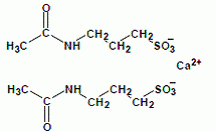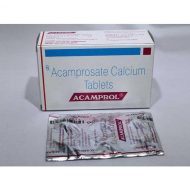Many drugs on the market work in mysterious ways. Scientists still don’t know how aspirin works. They still don’t know how Prozac works, or any of the antipsychotics. But how a drug works is not necessarily important. When you need to prevent suffering and death, what is important is that the drug works, and works safely. How it works can wait.
But sometimes when a drug mechanism reveals itself, it’s a surprise. That was the case in a recent study of acamprosate, one of four drugs approved in the United States as a pharmacological treatment for alcoholism. It turns out that acamprosate itself might not be the active ingredient. Instead, the calcium ions attached to the drug could be driving its anti-relapse effects.
Rainer Spanagel and his colleagues at the Central Institute of Mental Health and the University of Heidelberg in Mannheim, Germany, were one of the first groups to study acamprosate. Their previous studies showed that long-term abstinence from alcohol could produce increases in glutamate levels in the brain. Glutamate is an amino acid and one of the chemical messengers in the brain. The increase in glutamate creates an excited brain state, and could make alcoholics more likely to relapse and drink again.
Studies with acamprosate, or specifically with the calcium salt of acamprosate, a form of the drug that’s coupled with calcium ions, show that it can reduce relapse after withdrawal in mouse models of alcoholism. It also helps calm down the increases in glutamate in human alcoholics.
Spanagel and his group wanted to understand why acamprosate was able to reduce relapse, and if possible, how they could make the drug more effective. Calcium acamprosate is the approved treatment, but relatively little of it gets into the brain. Spanagel commissioned another form of the drug, sodium acamprosate. In this form, more of the drug reached the brain. But, strangely, it didn’t work. It didn’t reduce alcohol consumption in rats after withdrawal.
Mystified, the scientists dug deeper. They showed that calcium acamprosate doesn’t act on receptors for glutamate, called NMDA receptors, which suggests that acamprosate doesn’t affect the glutamate system. Spanagel and his colleagues began to question whether acamprosate was biologically active at all.
So they went back to the original patent for acamprosate, where they found a clue. The patent states that “the calcium salt may be used as neurotropic agent; the magnesium salt as vasculotropic agent; the potassium salt as antiasthenic agent; the lithium salt may be used in for bipolar patients and the sodium salt in local treatments; the zinc salt may be used in dermatology.” Different salts of the same molecule, with very different functions. Right there in the wording of the patent was the suggestion that the ions — calium, lithium, potassium — could be the active agents.
In further tests, Spanagel and his group showed that calcium acamprosate, and not sodium acamprosate, reduced alcohol intake in booze-deprived rats. Even basic calcium chloride was able to reduce alcohol intake. In addition, the researchers found an association between levels of blood calcium and abstinence in people on acamprosate.
“It’s not every day you find an FDA approved medication where the salt is driving the effect,” says Jeff Weiner, an alcohol addiction researcher at Wake Forest School of Medicine. He notes that there needs to be confirmation of the results before acamprosate is declared inactive. There could be functions of acamprosate, or of calcium acamprosate specifically, that are currently undiscovered. “We’re going to need more data,” he says, “before we throw the drug out with the bathwater.”
Spanagel agrees that the results need to be replicated. “We are not claiming that any of the published results are wrong, the interpretation is wrong,” he says. And there are still many unanswered questions. Calcium levels in blood may not correspond to calcium levels in brain. High levels of calcium dosing can have adverse cardiac side effects. The blood levels of calcium in people being treated with calcium acamprosate normalized after the first month, even though abstinence continued. And the rats in the study showed reduced movement in response to calcium treatment. They might be reducing their alcohol intake because they are simply moving less.
And if calcium is the active agent, there’s still an important unanswered question: Scientists still don’t know how that calcium might be working stop alcoholics from going back to the bottle.
Markus Heilig, a psychiatrist with the National Institute of Alcohol Abuse and Alcoholism and the National Institute on Drug Abuse, wrote a commentary on the paper calling for a randomized clinical trial to look at acamprosate, its calcium salt, and calcium alone. “If we could figure out the actual mechanism and find something more specific and more potent, there’s probably something there,” he says. “Whether it’s the calcium or the acamprosate, it’s doing something for some people.”
But Heilig also emphasizes that the paper, while it raises more questions than it answers, “represents some of the best science.” Whether acamprosate will turn out to have effects on its own or whether it all turns out to be calcium, the study helps to further our understanding of how we might prevent relapse. “This is ultimately a story of how science is all about questioning everything,” Helig says, “including the things we think we know.”

